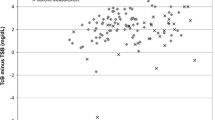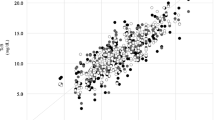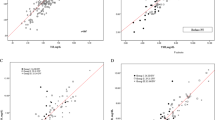Abstract
The objective of this study was to evaluate the correlation and agreement between transcutaneous and serum bilirubin among preterm low-birth-weight neonates. Neonates born at <35 weeks of gestation with birth weight <2,000 g were enrolled prospectively. Transcutaneous bilirubin (TcB) was measured at forehead, sternum, and abdomen at 24 ± 6 and 72 ± 12 h after birth and when icterus involved arms or legs (Kramer zone 4–5). Serum total bilirubin (STB) was measured by microbilimeter (STB-M) at all these time-points and by high-performance liquid chromatography (STB-H) at one randomly chosen time-point. A total of 1,619 observations were made in 256 neonates (median gestation, 34 weeks (IQR, 32–35), birth weight 1,522 ± 288 g). Overall there was excellent correlation and agreement between TcB and STB-M with TcB on forehead being most accurate (r = 0.84, mean difference, 0.3 ± 1.9 mg/dL) followed by TcB on abdomen (r = 0.73, mean difference, 1.5 ± 2.6 mg/dL) and sternum (r = 0.72, mean difference, 1.5 ± 2.6 mg/dL). TcB performed well at all three points of measurement with best correlations being observed at icterus level 4/5. Correlation between TcB and STB-H measured by high-performance liquid chromatography was less strong but significant (r = 0.59 to 0.69 at different time points of measurement). Conclusions: TcB has good correlation and agreement with STB in preterm low-birth-weight neonates born at ≥28 weeks of gestation.



Similar content being viewed by others
Abbreviations
- HPLC:
-
High-performance liquid chromatography
- LBW:
-
Low birth weight
- STB:
-
Serum total bilirubin
- STB-M:
-
Serum total bilirubin measured by microbilimeter
- STB-H:
-
Serum total bilirubin measured by high-performance liquid chromatography
- TcB:
-
Transcutaneous bilirubin
- VLBW:
-
Very low birth weight
References
Agarwal R, Kaushal M, Aggarwal R, Paul VK, Deorari AK (2002) Early neonatal hyperbilirubinemia using first day serum bilirubin level. Indian Pediatr 39(8):724–730
Amato M (1994) Transcutaneous, capillary, and arterial bilirubin levels. J Pediatr 125(2):332
Amato M, Huppi P, Markus D (1990) Assessment of neonatal jaundice in low birth weight infants comparing transcutaneous, capillary and arterial bilirubin levels. Eur J Pediatr 150(1):59–61
De Luca D, Zecca E, de Turris P, Barbato G, Marras M, Romagnoli C (2007) Using BiliCheck for preterm neonates in a sub-intensive unit: diagnostic usefulness and suitability. Early Hum Dev 83(5):313–317
Donzelli G, Pratesi S (2000) Transcutaneous bilirubinometry in healthy preterm newborns. Clin Biochem 33(6):505–508
Ebbesen F, Brodersen R (1982) Risk of bilirubin acid precipitation in preterm infants with respiratory distress syndrome: considerations of blood/brain bilirubin transfer equilibrium. Early Hum Dev 6(4):341–355
Hack M, Horbar JD, Malloy MH, Tyson JE, Wright E, Wright L (1991) Very low birth weight outcomes of the National Institute of Child Health and Human Development Neonatal Network. Pediatrics 87(5):587–597
Ho EY, Lee SY, Chow CB, Chung JW (2006) BiliCheck transcutaneous bilirubinometer: a screening tool for neonatal jaundice in the Chinese population. Hong Kong Med J 12(2):99–102
Holland L, Blick K (2009) Implementing and validating transcutaneous bilirubinometry for neonates. Am J Clin Pathol 132(4):555–561
Ip S, Chung M, Kulig J, O’Brien R, Sege R, Glicken S, Maisels MJ, Lau J (2004) An evidence-based review of important issues concerning neonatal hyperbilirubinemia. Pediatrics 114(1):e130–e153
Karolyi L, Pohlandt F, Muche R, Franz AR, Mihatsch WA (2004) Transcutaneous bilirubinometry in very low birthweight infants. Acta Paediatr 93(7):941–944
Knupfer M, Pulzer F, Braun L, Heilmann A, Robel-Tillig E, Vogtmann C (2001) Transcutaneous bilirubinometry in preterm infants. Acta Paediatr 90(8):899–903
Kramer LI (1969) Advancement of dermal icterus in the jaundiced newborn. Am J Dis Child 118(3):454–458
Lo SF, Doumas BT (2011) The status of bilirubin measurements in U.S. laboratories: why is accuracy elusive? Semin Perinatol 35(3):141–147
Maisels MJ, Bhutani VK, Bogen D, Newman TB, Stark AR, Watchko JF (2009) Hyperbilirubinemia in the newborn infant > or =35 weeks’ gestation: an update with clarifications. Pediatrics 124(4):1193–1198
Management of hyperbilirubinemia in the newborn infant 35 or more weeks of gestation (2004). Pediatrics 114 (1):297–316
Mercanti I, Michel F, Thomachot L, Loundou DA, Nicaise C, Vialet R, Di Marco JN, Lagier P, Martin C (2007) Transcutaneous bilirubin measurement in preterm infants. Arch Pediatr 14(7):875–880
Mishra S, Agarwal R, Deorari AK, Paul VK (2008) Jaundice in the newborns. Indian J Pediatr 75(2):157–163
Mishra S, Chawla D, Agarwal R, Deorari AK, Paul VK (2010) Transcutaneous bilirubin levels in healthy term and late preterm Indian neonates. Indian J Pediatr 77(1):45–50
Mishra S, Chawla D, Agarwal R, Deorari AK, Paul VK, Bhutani VK (2009) Transcutaneous bilirubinometry reduces the need for blood sampling in neonates with visible jaundice. Acta Paediatr 98(12):1916–1919
Namba F, Kitajima H (2007) Utility of a new transcutaneous jaundice device with two optical paths in premature infants. Pediatr Int 49(4):497–501
Narang A, Kumar P, Kumar R (2001) Neonatal jaundice in very low birth weight babies. Indian J Pediatr 68(4):307–309
Pathak U, Chawla D, Kaur S, Jain S (2013) Bilirubin nomogram for prediction of significant hyperbilirubinemia in north Indian neonates. Indian Pediatr 50(4):383–389
Rubaltelli FF, Gourley GR, Loskamp N, Modi N, Roth-Kleiner M, Sender A, Vert P (2001) Transcutaneous bilirubin measurement: a multicenter evaluation of a new device. Pediatrics 107(6):1264–1271
Sajjadian N, Shajari H, Saalehi Z, Esphahani F, Alizadeh Taheri P (2012) Transcutaneous bilirubin measurement in preterm neonates. Acta Med Iran 50(11):765–770
Schmidt ET, Wheeler CA, Jackson GL, Engle WD (2009) Evaluation of transcutaneous bilirubinometry in preterm neonates. J Perinatol 29(8):564–569
Stillova L, Matasova K, Mikitova T, Stilla J, Kolarovszka H, Zibolen M (2007) Evaluation of transcutaneous bilirubinometry in preterm infants of gestational age 32–34 weeks. Biomed Pap Med Fac Univ Palacky Olomouc Czech Repub 151(2):267–271
Stillova L, Matasova K, Zibolen M, Stilla J, Kolarovszka H (2009) Transcutaneous bilirubinometry in preterm neonates. Indian Pediatr 46(5):405–408
Szabo P, Wolf M, Bucher HU, Haensse D, Fauchere JC, Arlettaz R (2004) Assessment of jaundice in preterm neonates: comparison between clinical assessment, two transcutaneous bilirubinometers and serum bilirubin values. Acta Paediatr 93(11):1491–1495
Tan KL, Dong F (2003) Transcutaneous bilirubinometry during and after phototherapy. Acta Paediatr 92(3):327–331
Vreman HJ, Verter J, Oh W, Fanaroff AA, Wright LL, Lemons JA, Shankaran S, Tyson JE, Korones SB, Bauer CR, Stoll BJ, Papile LA, Donovan EF, Ehrenkranz RA, Stevenson DK (1996) Interlaboratory variability of bilirubin measurements. Clin Chem 42(6 Pt 1):869–873
Willems WA, van den Berg LM, de Wit H, Molendijk A (2004) Transcutaneous bilirubinometry with the Bilicheck in very premature newborns. J Matern Fetal Neonatal Med 16(4):209–214
Zhang J (1992) Analysis of unconjugated bilirubin in serum by reversed-phase high performance liquid chromatography. Scand J Clin Lab Invest 52(6):565–569
Funding source
Study was funded by extramural research grant from Indian Council of Medical Research (IRIS ID, 2008–02250)
Financial disclosure
None of the authors have any financial relationships relevant to this article to disclose.
Conflict of interest
The authors declare that they have no conflict of interest. None of the authors have any financial relationship with the organization that sponsored the research.
Author information
Authors and Affiliations
Corresponding author
Rights and permissions
About this article
Cite this article
Chawla, D., Jain, S., Kaur, G. et al. Accuracy of transcutaneous bilirubin measurement in preterm low-birth-weight neonates. Eur J Pediatr 173, 173–179 (2014). https://doi.org/10.1007/s00431-013-2142-0
Received:
Accepted:
Published:
Issue Date:
DOI: https://doi.org/10.1007/s00431-013-2142-0




